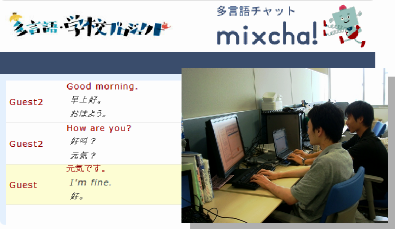Contents
[Langrid ToolBox Prototype Has Been Released]
![]()
[A New Language Service: HTML Text Extractor]
![]()
[Monthly Maintenance for September]
![]()
[Language Grid Playground Used in NPO Pangaea's Activity]
![]()
[Language Grid Users] Kuwabara Lab, Ritsumeikan University
![]()
Langrid ToolBox Prototype Has Been Released
The NICT Language Grid Project is going to release Langrid ToolBox, a multilingual collaboration tool based on a Content Management System (CMS), at the end of September. They have released a prototype of the tool and are now receiving comments from the users in order to improve the tool’s usability. Information on the prototype will be sent to users via mailing list.(toolbox-user[at]khn.nict.go.jp)
If you wish to try the prototype, send a request to join the mailing list to the following address: asukam[at]nict.go.jp
A New Language Service: HTML Text Extractor
A new language service, "HTML Text Extractor," has been added to the Language Grid.
The HTML Text Extractor separates an HTML document into texts and HTML tags. Uniquely specified keys are positioned where the texts existed so you can replace the keys with corresponding texts and easily restore the original HTML document. If you translate the extracted texts into another language with the language services on the Language Grid and use them to restore the HTML document, you can create multilingual HTML documents and use this function for Website translation. For details, including interface information, check the profile of the service on the Service Manager.
Monthly Maintenance for September
The next maintenance on the Language Grid will be conducted on Monday, September 7, 18:00 -21:00 JST. If you wish to use the Language Grid during this period, please contact us in advance at operation [at] langrid.org.
Language Grid Playground Used in NPO Pangaea's Activity
On July 25th, NPO Pangaea held a real-time Webcam activity between Kyoto and Malaysia for the first time. Many children-21 children at the Kyoto site and 20 children at the Malaysia site-enjoyed the activity.
Previously, NPO Pangaea used the Language Grid only within the staff members through the Langrid Input & Chat (the collaboration tools developed by NICT), a community site (bulletin board system) originally developed by Pangaea, and a Webcam chat system. It was the first opportunity for the children to use the Language Grid.
The new activity, called "Nazoren," is a word association game in which children guess the answer from the clues given by the other site. The Japan site and the Malaysia site (this time they used English and Chinese) cannot exchange the clues because of the language barrier, so they used the Language Grid Playground before the activity and thought of good clues to be properly translated and understood by the other site. In the activity, they gave the other site the clues via a multilingual Webcam chat system. Children typed on keyboards and tried hard to think of good clues. It was impressive to see the smiling children enjoying their “bonds” through the Web, while they became excited or disappointed with the right/wrong answers.
(Photo credit: NPO Pangaea)
Language Grid Users: Kuwabara Lab, Ritsumeikan University

The Semantic Communication Laboratory of the Department of Information & Communication Science in the College of Information Science & Engineering at Ritsumeikan University aims to realize a platform to support communication and collaboration over the network by using technologies such as multi-agent and semantic Web.
With regard to the connection with the Language Grid, we participate in SIGMUSE (Special Interest Group on Multilingual Support for Education) of the Language Grid Association, and join the Multilingual School Project. As one of the activities of this project, we are developing a multilingual chat (electronic communication in writing) system called "mixcha!". We are also trying to combine a multilingual chat system with an image database and a tool attaching hiragana for reading, and to realize a simple interface for obtaining multilingual texts.
We have discovered how easily we can develop applications that handle different languages with the services, including machine translators, provided by the Language Grid. Since the Language Grid is also a simple example of Web services, it is a good opportunity for the students to experience the practical system architecture through using the Language Grid.
